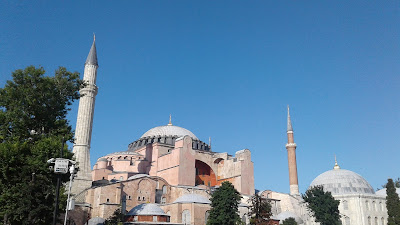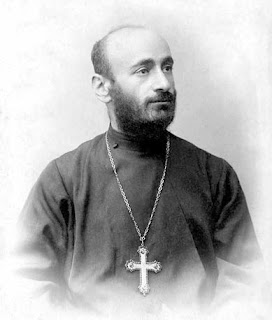Hagia Sophia at Noon and at Dusk
Impressions on Hagia Sophia
Hagia
Sophia the important church and mosque stands on the fault line between East
and West and it is the embodiment of that face off like Jerusalem. A symbol of synthesis
and conflict at the same time, it is so natural that it stands here, right in
the bottle neck between East and West, on that old city of Istanbul. When it
was built for the third time (537) after the notorious Nika revolt there wasn’t
anything that came close to it.
Personal
memories mix with history here. Whenever I felt stressful and I want to stay
away from the daily hassle of life, my feet take me to the historical peninsula
and especially to this monument in my university years. I think when I saw it
how it stood in its glorious past and seeing Justinianus and Constantine on the
mosaics it let me feel like I am recalling the poem Ozymandias of Shelley.
And on the pedestal these words appear:
'My name is Ozymandias, king of kings:
Look on my works, ye Mighty, and despair!'
Nothing beside remains. Round the decay
Of that colossal wreck, boundless and bare
The lone and level sands stretch far away."
'My name is Ozymandias, king of kings:
Look on my works, ye Mighty, and despair!'
Nothing beside remains. Round the decay
Of that colossal wreck, boundless and bare
The lone and level sands stretch far away."
When I was passing
through the huge wooden door into the vast closed space under a peaceful dome
that diminishes the energy of light as if civilizing it through its forty
windows, I think I saw pigeons fluttering during winter when not as many
tourists are visiting as today. A bit of a challenging climb to the upper
gallery through the humid corridors (not stairs I have to mention) that has a
medium slope where only a faint light could come through the blurry windows.
As of 2016 no
one is allowed to pray inside, Christian or Muslim. I saw a security guard who
gently and firmly let a woman who naturally got carried away rise from kneeling
down and pray in front of the sculpture of Christ. And for Muslims in Turkey
even though they don’t pray inside, adhan (ezan) is called from its minarets.
This monument of Christianity and later on adopted by Islam became a museum and
had its religious affairs come to a halt after the foundation of the Turkish
Republic which led to an argument that still goes on today. I may go into the
details of that argument later.
The name of
the mosque stayed the same as of the church, Ayasofya Camii Kebiri (The Grand
Mosque of Hagia Sophia), one also finds to his or her amazement. Its name was
Greek and after the conquest was kept Greek in an act of respect to its
historical and stately value. They thought a new name would ruin it maybe.
Mehmet the Conquerer had for himself built a different mosque on the third hill
of Istanbul but Hagia Sophia Mosque continued to be the imperial mosque
continuing the tradition set by the Byzantines.
The light doesn’t shine but touches on the interior so softly it takes on a mystical air and makes one actually feel the word “Holy Wisdom”.
John Freely,
a veteran of Istanbul travels describes his first impression:
“My initial and abiding impression was that of an immense enclosed space, penetrated by beams of dust-speckled sunlight coming from the circlet of windows below the dome, the only sounds being the echoing murmur of doves and the occasional flutter of their wings from the vaults above.”1
I think
that scene mostly remained till the beginning of the new millennia. The “dust-speckled
sunlight” must have shone as softly on the imperial household, a long line of emperors
and empress who sat there that come and gone, on many sultans to come who
prayed at noon on Fridays on the carpets covering the stone floor, and on the
19th century workers who washed the white plaster away first time
since the conquest to get a glimpse on the mosaics that kept covered for 400
years during the reign of Abdülmecit. Fossati brothers were there, under that
same light when they were copying the mosaics on paper later to locate them.1
Updated on
June 23, 2016
References
1. Freely,
J. (2005) John Freely’s Istanbul. London: Scala Publishers Ltd.



Comments
Post a Comment